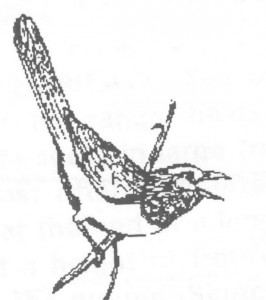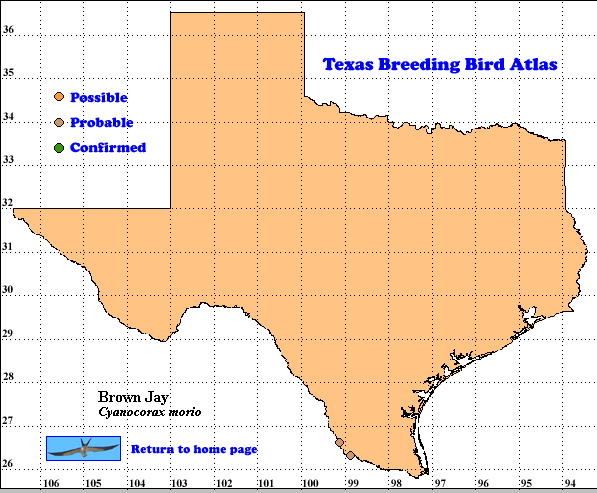The range of this large (43 cm, 17 in), non-migrating jay reaches its extreme northern limit in western Starr County, Texas, between Falcon Dam (latilong 26099-E2) in the north- west and the state-owned White-winged Dove (Zenaida asiatica) land just south of Rosita (26098-C8), between Rio Grande City and Roma. Pairs have been found at the Rosita location and on a long island in the Rio Grande (26099-E1), 0.5 km (0.3 mi) south of Salineño.
Young Brown Jays can usually be aged through their second summer.. The youngest birds have yellow eyerings, yellow legs and yellow bills; after six months or so the eyerings disappear. The yellow bill continues for a year and the second-year bird may have a partly black, partly yellow beak, especially the lower mandible. The fully mature bird has a black eyering, bill and legs (Pyle 1997, DDH)..
The Brown Jay has its often-heard alarm call, variously described as: monotonous and obnoxious, an all-too-soon familiar loud screaming kyeeah! or k’yaah! and kaah! kaah!, (Howell and Webb 1995), a strident, often-repeated chaa or pyaaaah that varies in pitch and intonation (Stiles and Skutch 1989), a slightly nasal peow, sometimes so loud and explosive it almost sounds like pow reaching a pitch of D4 (Davis 1972), a harsh thief!, thief!, thief!, higher pitched than a Blue Jay (Cyanocitta cristata; Peterson and Chalif 1973) or mimicking a Red-shouldered Hawk (Buteo lineatus; Tveten 1993).
DISTRIBUTION. In Texas Brown Jays are only found in western Starr County, 100 km (65 mi) northwest of McAllen. Below Falcon Dam, Brown Jays are often heard, in winter as they travel through the woods from the clothesline post at the old “hobo” (fisher- mans) camp to the Girl Scout camp. When silent, they are hard to locate. They are also seen at the Santa Margarita Ranch and other riparian areas, mainly with no public entry allowed. In the 1990
They range south through Tamaulipas and Nuevo Leon in northeastern Mexico south to Panama along the Gulf-Caribbean slope below 1,500 m (5000 ft) elevation. From central Veracruz south, a color morph with brighter brown and white colors, and white tail tips, is found. This was formerly known as the White-tipped Brown Jay, (C. mexicanus; Howell and Webb 1995, Am. Ornithol. Union 1998).
SEASONAL OCCURRENCE. The Brown Jay in its very limited area of occurrence in Starr County, Texas is a permanent resident. These birds are most easily seen from late November to mid-February when flocks visit feeders at Salineño, 7 km (4 mi) southeast of Falcon Dam. Shortly after, the flocks break up and the birds pair off. The breeding season extends from late February to at least June based on TBBA dates of April 2, May 10 and June 2 for pairs on nests. Following nesting groups of 6 to15 or more may roam for kilometers. These birds are generally seen in flocks of young, with perhaps one or two whose bills have turned partly black.
BREEDING HABITAT. The Brown Jay uses a cooperative breeding system involving one or more females and younger helpers. More than one nest may be constructed and females may lay eggs in more than one nest and, share incubation and brooding. Nestlings may be fed by a number of flock members. Flocks containing older jays usually have higher breeding success (Lawton and Lawton 1985). Throughout its range the species nests in open woodlands, forest edge, second-growth forests, clearings, and plantations. These jays choose sites high in inaccessible spots in large trees. The nest is most often supported among twigs at the end of a long, narrow branch from 7.5-15 m (25-50 ft) above ground (Skutch 1960). Nest building by Brown Jays is a noisy performance as soon as the site is selected and the first stick is laid. The birds take turns sitting in it and uttering loud, monotonous calls which can be heard for a long distance. The sound, a loud, sad pee-ah, is used by nesting birds as well as fledglings begging for food. Both male and female and often year-lings (which aid by warning of danger) use this call (Skutch 1960).
If the first brood fails, a second nesting takes place. The female broods the nestlings while she imitates a young bird. If she has warmed the nest and desires a free period, she flies away after being fed. The male stands on the rim of the nest, guarding the eggs until she returns. Sometimes the helper year-lings bring food to the female. There are two or three bluish-gray eggs, thickly speckled with brown (Skutch 1960).
STATUS. Although the species had been sighted in Texas earlier (Oberholser 1974), the first nest of Brown Jay in Texas was found west of Roma in 1974. In 1975 an estimated population of 40-50 birds was scattered along the Rio Grande River from below Falcon Dam to Fronton with breeding apparently occurring annually (Harrison 1979). Since completion of the 1987-1992 TBBA field work the population has apparently declined with less than a dozen jays present from a population formerly considered uncommon and local. The population, centered around the villages of Chapeño and Salineño, crosses the river to and from Mexico. Although recent nesting has not been observed, flocks may contain young birds (Lockwood and Freeman 2004).
Text by Dick D. Heller, Jr. (1995, posted with updates 2006)
Literature cited.
American Ornithologists’ Union. 1998. Checklist of North American birds, 7th ed. Am, Ornithol. Union, Washington, DC.
Davis, L. I. 1972. A field guide to the birds of Mexico and Central America. University of Texas Press, Austin.
Harrison, H. H. 1979. A field guide to western birds’ nests. Houghton Mifflin, Boston, MA.
Howell, S. N. G. and S. Webb. 1995. A guide to the birds of Mexico and northern Central America. Oxford University Press, New York.
Layton, M. F. and R. O. Layton. 1985. The breeding biology of the Brown Jay in Monteverde, Costa Rica. Condor 87: 192-204.
Lockwood, M. W. and B. Freeman. 2004. The TOS handbook of Texas birds. Texas A&M University Press, College Station.
Oberholser, H. C. 1974. The bird life of Texas. University of Texas Press, Austin.
Peterson, R. T. and E. L. Chalif. 1973/ A field guide to Mexican birds. Houghton Mifflin, Boston,, MA.
Pyle, P. 1997. Identification guide to North American birds, part 1. Slate Creek Press, Bolinas, CA.
Skutch , A. F. 1960. Life histories of Central American birds II. Pac. Coast Avifauna 34: 231-257′
Stiles, F. G. and A. F. Skutch. 1989. A guide to the birds of Costa Rica. Cornell University Press, Ithaca, NY.
Tveten, J. L. 1993. The birds of Texas. Shearer Publications, Fredricksburg.

